2013–14 South Pacific cyclone season
The 2013–14 South Pacific cyclone season was a slightly below average tropical cyclone season, with six tropical cyclones occurring within the basin between 160°E and 120°W. The season ran from November 1, 2013 to April 30, 2014, however, the first four tropical disturbances occurred during October 2013 and were included as a part of the season. During the season, tropical cyclones were officially monitored by the Fiji Meteorological Service (FMS), Australian Bureau of Meteorology (BoM) and New Zealand's MetService. The United States Joint Typhoon Warning Center (JTWC) and other national meteorological services including Météo-France and NOAA also monitored the basin during the season. During the season there were 21 significant tropical disturbances were assigned a number and an "F" suffix by the FMS's Regional Specialized Meteorological Center in Nadi, Fiji (RSMC Nadi), including the remnants of Tropical Cyclone Hadi from the Australian region. The BoM, MetService and RSMC Nadi all estimated sustained wind speeds over a period of 10-minutes and used the Australian tropical cyclone intensity scale, while the JTWC estimated sustained winds over a 1-minute period, which are subsequently compared to the Saffir–Simpson hurricane wind scale (SSHS).
| 2013–14 South Pacific cyclone season | |
|---|---|
 Season summary map | |
| Seasonal boundaries | |
| First system formed | October 19, 2013 |
| Last system dissipated | March 20, 2014 |
| Strongest storm | |
| Name | Ian |
| • Maximum winds | 205 km/h (125 mph) (10-minute sustained) |
| • Lowest pressure | 930 hPa (mbar) |
| Seasonal statistics | |
| Total disturbances | 20 |
| Total depressions | 13 |
| Tropical cyclones | 6 |
| Severe tropical cyclones | 2 |
| Total fatalities | 12 total |
| Total damage | $48 million (2014 USD) |
| Related articles | |
Seasonal forecasts
| Source/Record | Tropical Cyclone |
Severe Tropical Cyclone |
Ref |
|---|---|---|---|
| Record high: | 1997–98: 16 | 1982–83:10 | [1] |
| Record low: | 2011–12: 3 | 2008–09: 0 | [1] |
| Average (1969-70 - 2012-13): | 7.4 | - | [2] |
| RSMC Nadi | 4-8 | 2-4 | [2] |
| NIWA | 8-12 | 4 | [3] |
| Actual | 6 | 2 | |
| Region | Chance of above average activity |
Average number |
Actual activity |
| Southern Pacific | 48% | 15 | 8 |
| Western South Pacific | 56% | 8 | 4 |
| Eastern South Pacific | 47% | 11 | 4 |
| Source:BOM's Seasonal Outlooks for Tropical Cyclones.[4] | |||
Ahead of the cyclone season, the BoM, the FMS, MetService, the New Zealand National Institute of Water and Atmospheric Research (NIWA) and various other Pacific Meteorological services, all contributed towards the Island Climate Update tropical cyclone outlook that was released during October 2013.[3][5] The outlook took into account the ENSO neutral conditions that had been observed across the Pacific and analogue seasons that had ENSO neutral conditions occurring during the season.[3] The outlook called for a near average number of tropical cyclones for the 2013–14 season, with eight to twelve named tropical cyclones, to occur between 135°E and 120°W compared to an average of 10.[3] At least four of the tropical cyclones were expected to become category 3 severe tropical cyclones, while three could become category 4 severe tropical cyclones, they also noted that a Category 5 severe tropical cyclone was unlikely to occur.[3][5] In addition to contributing towards the Island Climate Update outlook, the FMS and the BoM both issued their own seasonal forecasts for the South Pacific region.[2][4]
The BoM issued 3 seasonal forecasts for the South Pacific region between 142.5°E and 120°W, one for the Western Southern Pacific region between 142.5°E and 165°E and one for the Eastern Southern Pacific region between 165°E and 120°W.[4] They noted that the tropical Pacific Ocean was currently experiencing neutral ENSO conditions which meant that there was no strong shift expected in the average location of tropical cyclone formation.[4] They also noted that there was nothing in the broad climate drivers to suggest anything, but a typical tropical cyclone season for the South Pacific region.[4] As a result, they predicted that the South Pacific region as a whole, would experience near average tropical cyclone activity during the coming season with a 48% chance of it being above average.[4] The Western region was predicted to have 56% chance of being above average while the Eastern region had a 47% chance of being above average.[4] Within their outlook the FMS predicted that between four and eight tropical cyclones, would occur within the basin compared to an average of around 7.4 cyclones.[2] At least two of the tropical cyclones were expected to become category 3 severe tropical cyclones, while 1-2 might intensify into a category 4 or 5 severe tropical cyclones.[2] They also reported that the tropical cyclone genesis trough was expected to be located near to and to the west of the International Dateline.[2] This was based on the expected and predicted ENSO conditions, and the existence of the Pacific warm pool of sub-surface temperature anomalies in this region.[2]
The FMS and Island Climate Update tropical cyclone outlooks both assessed, the risk of a tropical cyclone affecting a certain island or territory.[2][3] As the tropical cyclone genesis trough of low pressure was expected to be located near to and to the west of the International Dateline, normal or slightly above normal activity was expected for areas near the dateline.[2][3] It was also predicted that activity between Vanuatu and New Caledonia, as well as east of the International Date Line to be normal or below normal during the season.[3] The Island Climate Update Outlook predicted that Vanuatu and New Caledonia had a reduced chance of being affected by multiple tropical cyclones.[3] The Cook Islands, Fiji, Papua New Guinea, Tuvalu, Tokelau, Samoan Islands, Solomon Islands, Tonga, Wallis and Futuna and French Polynesia's Austral and Society Islands were all predicted to have a normal chance of being affected by a tropical cyclone.[3] Niue and New Zealand were predicted to face an elevated risk while French Polynesia's Tuamotu Archipelago and Marquesas Islands, Kiribati and the Pitcairn Islands, had an unlikely chance of being affected by a tropical cyclone.[3] The FMS outlook predicted that the Cook and Samoan Islands, Tokelau and Niue had a below average risk of being affected by a tropical cyclone.[2] The Solomon Islands, Wallis and Futuna, Vanuatu and Tonga were predicted to face an average risk of being affected by a tropical cyclone.[2] New Caledonia, Tuvalu and Fiji were predicted to face an above average chance of being affected by a tropical cyclone.[2] The FMS also predicted that there was an increased risk of severe tropical cyclones, affecting the region this year when compared to the previous season.[6] There was a very high risk of Wallis and Futuna, Tonga, Fiji and New Caledonia being affected by a severe tropical cyclone.[6] The Samoan Islands, Tokelau, Niue, Solomon Islands and Vanuatu had a high risk, while the Cook Islands had a low to moderate risk of being affected by a severe tropical cyclone.[6]
Seasonal summary

Ahead of the season formally starting on November 1, 2013, three tropical depressions and a tropical disturbance developed, within the Coral Sea during October.[6][7] Tropical Disturbance 01F developed on October 19, to the southeast of the Solomon Islands and moved westwards, as a small compact system before it was last noted during the next day.[7][8] Tropical Depression 02F was first noted on October 19, to the northeast of Suva, Fiji, over the next couple of days the system rapidly consolidated further.[7] However, despite having a good chance of developing into a tropical cyclone, atmospheric convection surrounding the system failed to consolidate enough.[9][10] The system was subsequently last noted on October 26, as it moved through the island nation of Vanuatu.[7] Tropical Depression 03F was briefly noted on October 22, to the northeast of Honiara on the Solomon Island of Guadalcanal. Tropical Depression 04F developed on October 25, to the southeast of Honiara and affected the islands before RSMC Nadi issued its final advisory on the system during October 27, as it was not expected to develop into a tropical cyclone.
Systems
Tropical Depression 02F
| Tropical depression (Australian scale) | |
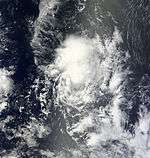  | |
| Duration | October 19 – October 23 |
|---|---|
| Peak intensity | Winds not specified 1002 hPa (mbar) |
Early on October 19, RSMC Nadi reported that Tropical Disturbance 02F had developed, about 1,550 km (965 mi) to the northeast of Suva, Fiji.[11] Over the next day the system moved westwards within an area of low vertical wind shear and rapidly consolidated further and became a tropical depression during October 20.[12][13] After the system had started to move towards the south-southwest and continued to consolidate, the Joint Typhoon Warning Center issued a tropical cyclone formation alert for the system during October 21.[9] However, this alert was cancelled during the next day after satellite imagery revealed a poorly defined low level circulation center, with unorganized atmospheric convection that had not consolidated and vertical wind shear over the system had started to increase.[10] RSMC Nadi subsequently issued their final warning on the system during October 23, as the system weakened into an area of low pressure over the islands of Vanuatu.[7][14] However, the remnant area of low pressure was monitored until October 26, as it moved through Vanuatu.[7]
Between October 23–24, heavy rainfall associated with the system, caused flooding and landslides on the island of Paama in Malampa Province.[15][16] Because of the islands geography, impacts were reported to most villages on the island with specific damage reported to homes, roads, a school and the islands air strip.[15] Other impacts included over 160 food gardens being destroyed and the ground water supply was contaminated.[15]
Severe Tropical Cyclone Ian
| Category 5 severe tropical cyclone (Australian scale) | |
| Category 4 tropical cyclone (SSHWS) | |
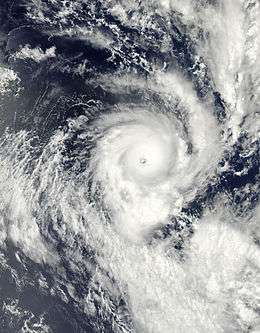 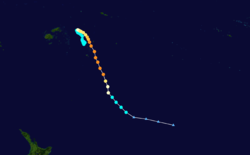 | |
| Duration | January 2 – January 14 |
|---|---|
| Peak intensity | 205 km/h (125 mph) (10-min) 935 hPa (mbar) |
During January 2, RSMC Nadi reported that Tropical Disturbance 07F had developed to the southeast of Futuna Island.[17] Over the next three days the system gradually developed further underneath an upper level ridge of high pressure, within an area of moderate vertical wind shear, as it slowly moved towards the southwest.[17][18][19] Late on January 5, the JTWC designated the system as Tropical Cyclone 07P, before RSMC Nadi named the system Ian, after it had become a category 1 tropical cyclone on the Australian scale.[20][21]
Tropical Cyclone June
| Category 1 tropical cyclone (Australian scale) | |
| Tropical storm (SSHWS) | |
 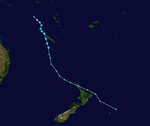 | |
| Duration | January 13 – January 19 |
|---|---|
| Peak intensity | 75 km/h (45 mph) (10-min) 990 hPa (mbar) |
During January 13, the FMS reported that Tropical Disturbance 08F had developed, along a surface trough of low pressure to the southeast of the Solomon Island Makira.[22] Over the next couple of days the system moved south-westwards and moved into the Australian region during January 15, where it was classified as a monsoonal low.[23][24] The disturbance, however, exited that basin on January 16 without upgrading it to a tropical cyclone.[24][25] The RSMC Nadi had reported that the system intensified into a Category 1 tropical cyclone and was named June the next day.[26]
June caused at least one fatality in New Caledonia, possibly two.[27]
Tropical Cyclone Edna
| Category 2 tropical cyclone (Australian scale) | |
| Tropical storm (SSHWS) | |
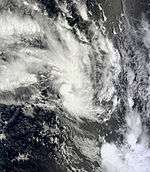  | |
| Duration | February 4 (Entered basin) – February 6 |
|---|---|
| Peak intensity | 95 km/h (60 mph) (10-min) 985 hPa (mbar) |
During February 4, Tropical Cyclone Edna moved into the basin, just after deep convection surrounding the system had significantly improved and it had re-intensified into a tropical cyclone.[28][29][30] Over the next day the system was steered to the south-southeast by a mid-level ridge of high pressure and affected the French Territory of New Caledonia. Both RSMC Nadi and JTWC subsequently estimated that the system had reached its peak sustained winds of 90 km/h (55 mph), which made it a category 2 tropical cyclone on the Australian scale.
Tropical Cyclone Kofi
| Category 2 tropical cyclone (Australian scale) | |
| Tropical storm (SSHWS) | |
 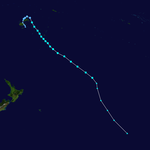 | |
| Duration | February 24 – March 4 |
|---|---|
| Peak intensity | 100 km/h (65 mph) (10-min) 980 hPa (mbar) |
On February 24, RSMC Nadi reported that Tropical Depression 15F had developed about 265 km (165 mi) west of Nadi, Fiji.[31] This was quite close to Tropical Depression 14F, and JTWC appear to have regarded them as the same system. There had also been severe flooding in Central and Eastern parts of Fiji Islands on February 27. During Kofi's duration, the system submerged many homes in the Fiji Islands.
Severe Tropical Cyclone Lusi
| Category 3 severe tropical cyclone (Australian scale) | |
| Category 1 tropical cyclone (SSHWS) | |
  | |
| Duration | March 7 – March 14 |
|---|---|
| Peak intensity | 150 km/h (90 mph) (10-min) 960 hPa (mbar) |
Early on March 7, RSMC Nadi reported that Tropical Disturbance 18F had developed about 685 km (425 mi) to the west of Nadi, Fiji.[32][33] Over the next two days the system moved towards the north-northwest and slowly consolidated, as atmospheric convection wrapped into the systems low level circulation center, before RSMC Nadi reported during March 9, that the system had developed into a tropical depression.[34][35]
Tropical Cyclone Mike
| Category 1 tropical cyclone (Australian scale) | |
| Tropical storm (SSHWS) | |
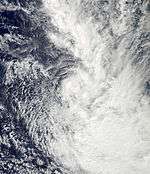 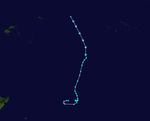 | |
| Duration | March 12 – March 20 |
|---|---|
| Peak intensity | 65 km/h (40 mph) (10-min) 990 hPa (mbar) |
On March 12, RSMC Nadi reported that Tropical Disturbance 19F had developed about 250 km (155 mi) to the southeast of Pago Pago, American Samoa.[36] Over the next few days the system gradually developed further before early on March 19, RSMC Nadi reported the system had become a category 1 tropical cyclone on the Australian scale and named it Mike.[37] The JTWC subsequently initiated advisories on the system and assigned it the designation Tropical Cyclone 20P.[38] Later that day RSMC Nadi and the JTWC issued their final advisories on Mike, as it moved below 25S and transitioned into an extratropical cyclone.[39][40] The extra-tropical remnants of the cyclone were subsequently monitored by TCWC Wellington, until they were last noted during March 24, while they were located over 1,700 km (1,055 mi) to the east of Wellington, New Zealand.[41]
Other systems
The first numbered tropical disturbance of the year developed within an area of low vertical wind shear, to the southeast of the Solomon Islands on October 19.[8][11] The system subsequently moved westwards as a small compact system, before it was during October 20 as it dissipated to the north of Vanuatu.[8][12][13] During the following day Tropical Disturbance 03F developed within an area of low shear, about 265 km (165 mi) to the northeast of Honiara on Guadalcanal in the Solomon Islands.[42] The system was last noted during October 22, after convection surrounding the centre had significantly reduced.[43][44] On October 25, the FMS reported that Tropical Depression 04F had developed under an upper level ridge of high pressure within an area of low windshear, about 330 km (205 mi) to the southeast of Honiara.[45] Over the next couple of days the system affected the Solomon Islands, before it was last noted during October 27, as it was not expected to develop into a Category 1 tropical cyclone.[46][47] A reanalysis of these three systems was performed by Steve Young during April 2014, who felt that these three systems represented one weak system that existed between October 18 – 27, near the Solomon Islands.[48]
On December 9, RSMC Nadi reported that Tropical Disturbance 05F had developed to the east of an upper level trough, in an area of moderate to high vertical windshear about 500 km (310 mi) to the northeast of Nadi, Fiji.[49][50] During that day the system moved towards the southeast and passed over the Fijian island of Viti Levu.[50][51][52] After passing over Fiji the system continued to move south-eastwards and developed into a tropical depression during December 11.[53] During December 12, the system passed about 30 km (20 mi) to the south of Tongatapu Island, before RSMC Nadi issued its final advisory on the system during the next day, as the system was not expected to develop into a tropical cyclone.[54][55] On December 23, RSMC Nadi reported that Tropical Disturbance 06F had developed under an upper level ridge of high pressure, within an area of moderate vertical wind shear to the northeast of the Santa Cruz Islands.[56] Over the next few days the system moved south-eastwards and influenced the "moist easterly wind flow" over the Fijian Islands until it was last noted during December 29.[52][57]
Late on January 21, RSMC Nadi reported that Tropical Depression 09F had developed about 340 km (210 mi) to the southwest of the Cook Island: Palmerston.[58] Over the next day the system moved westwards and developed into a tropical depression, while located within an area of low to moderate vertical windshear.[59] Over the next couple of days the JTWC also monitored the system as a subtropical system that was becoming tropical, before it was last noted by RSMC Nadi on January 24.[60][61][62] During January 22, RSMC Nadi also started monitoring Tropical Disturbance 10F, which had developed around 740 km (460 mi) to the northeast of Port Vila, Vanuatu.[59] The system lied within an area of moderate to high vertical windshear to the north of an upper level ridge of high pressure.[59] Over the next couple of days the system moved westwards into an area of low vertical windshear and the Australian region, where it developed into Tropical Cyclone Dylan during January 26.[62][63][64] Tropical Disturbance 11F subsequently developed to the southwest of Nadi, Fiji during January 29.[65] The system lay to the east of an upper level trough of low pressure within an area of high vertical windshear.[66] During that day the system moved towards the east-southeast and was subsequently last noted by RSMC Nadi later that day as it moved into TCWC Wellingtons area of responsibility.[66]
Tropical Disturbance 13F formed on February 16, to the north-northwest of Vanuatu. Due to unfavorable conditions of turning into a depression, 13F dissipated near a subtropical ridge early on February 19. During February 23, RSMC Nadi reported that Tropical Disturbance 14F had developed, within a trough of low pressure to the north-northwest of Maewo, Vanuatu.[67][68] Over the next day the system moved slowly towards the south-southeast and developed into a tropical depression.[69] Over the next two days the system continued to move towards the south-southeast and prompted heavy rain warnings for Fiji, before it dissipated during February 26.[67][70] Late on February 26, RSMC Nadi reported that Tropical Disturbance 16F, had developed about 90 km (55 mi) south of the Indispensable Reefs.[71] Over the next day the system moved westwards and moved into the Australian region, where it eventually developed into Tropical Cyclone Hadi during March 9. On March 6, RSMC Nadi reported that Tropical Disturbance 17F had developed about 80 km (50 mi) to the northeast of Port Vila, Vanuatu.[72] Over the next two days the system remained weak as it moved south-westwards, before it was last noted during March 8, as it moved into an area of moderate to high vertical windshear and the Australian Region.[73] Tropical Cyclone Hadi subsequently moved back into the South Pacific basin late on March 12, where RSMC Nadi designated it as Tropical Disturbance 20F.[74] On March 18, the Tropical Disturbance re-exited the South Pacific basin into the Australian basin. The last tropical disturbance of the season: 21F, formed on March 17, about 500 km (310 mi) to the north of Rarotonga in the Cook Islands,[75] before dissipating two days later.
Season effects
This table lists all the storms that developed in the South Pacific to the east of longitude 160°E during the 2013–2014 season. It includes their intensity on the Australian tropical cyclone intensity scale, duration, name, landfalls, deaths, and damages. All data is taken from RSMC Nadi and/or TCWC Wellington, and all of the damage figures are in 2014 USD.
| Name | Dates active | Peak classification | Sustained wind speeds |
Pressure | Areas affected | Damage (USD) |
Deaths | Refs |
|---|---|---|---|---|---|---|---|---|
| 01F | October 19 – 20 | Tropical disturbance | Not Specified | 1004 hPa (29.65 inHg) | Solomon Islands, Vanuatu | None | None | [7] |
| 02F | October 19 – 23 | Tropical depression | Not Specified | 1002 hPa (29.59 inHg) | Kiribati, Vanuatu | None | None | [7] |
| 03F | October 21 – 22 | Tropical depression | Not Specified | 1005 hPa (29.68 inHg) | Solomon Islands | None | None | [7] |
| 04F | October 25 – 27 | Tropical depression | Not Specified | 1007 hPa (29.74 inHg) | Solomon Islands | None | None | [7] |
| 05F | December 9 – 13 | Tropical depression | Not Specified | 999 hPa (29.50 inHg) | Fiji, Tonga | None | None | |
| 06F | December 23 – 29 | Tropical disturbance | Not Specified | 1003 hPa (29.62 inHg) | Vanuatu | None | None | |
| Ian | January 2 – 14 | Category 5 severe tropical cyclone | 205 km/h (125 mph) | 930 hPa (27.46 inHg) | Fiji, Tonga | $48 million | 1 | |
| June | January 13 – 19 | Category 1 tropical cyclone | 75 km/h (45 mph) | 990 hPa (29.23 inHg) | Solomon Islands, New Caledonia New Zealand | Minor | 1 | |
| 09F | January 21 – 24 | Tropical depression | Not Specified | 1004 hPa (29.65 inHg) | Cook Islands, Niue, Tonga | None | None | |
| 10F | January 22 – 24 | Tropical disturbance | Not Specified | 1004 hPa (29.65 inHg) | Solomon Islands | None | None | |
| 11F | January 29 | Tropical disturbance | Not Specified | 1000 hPa (29.53 inHg) | Fiji | None | None | |
| Edna | February 4 – 6 | Category 2 tropical cyclone | 95 km/h (60 mph) | 985 hPa (29.09 inHg) | New Caledonia, New Zealand | None | None | |
| 13F | February 16 – 19 | Tropical disturbance | Not Specified | 1003 hPa (29.62 inHg) | Vanuatu, Fiji | None | None | |
| 14F | February 23 – 26 | Tropical depression | Not Specified | 1002 hPa (29.59 inHg) | Vanuatu, Fiji | None | None | |
| Kofi | February 24 – March 4 | Category 2 tropical cyclone | 100 km/h (65 mph) | 980 hPa (28.94 inHg) | Fiji, Tonga | None | None | |
| 16F/20F (Hadi) | February 26 – 27 March 12 – 18 | Tropical disturbance | Not Specified | 1000 hPa (29.56 inHg) | Solomon Islands, Vanuatu | Unknown | None | |
| 17F | March 6 – 8 | Tropical disturbance | Not Specified | 1005 hPa (29.68 inHg) | Vanuatu | None | None | |
| Lusi | March 7 – 14 | Category 3 severe tropical cyclone | 150 km/h (90 mph) | 960 hPa (28.35 inHg) | Vanuatu, Fiji, New Zealand | Unknown | 10 | [76] |
| Mike | March 12 – 20 | Category 1 tropical cyclone | 65 km/h (40 mph) | 990 hPa (29.23 inHg) | Cook Islands | Minor | None | [77] |
| 21F | March 17 – 19 | Tropical depression | 45 km/h (30 mph) | 998 hPa (29.47 inHg) | None | None | None | |
| Season aggregates | ||||||||
| 20 systems | October 19 – March 20 | 205 km/h (125 mph) | 930 hPa (27.46 inHg) | $48 million | 12 | |||
See also
- Tropical cyclones in 2013 and 2014
- List of South Pacific cyclone seasons
- Atlantic hurricane seasons: 2013, 2014
- Pacific hurricane seasons: 2013, 2014
- Pacific typhoon seasons: 2013, 2014
- North Indian Ocean cyclone seasons: 2013, 2014
- 2013–14 South-West Indian Ocean cyclone season
- 2013–14 Australian region cyclone season
References
- Climate Services Division; RSMC Nadi — Tropical Cyclone Centre (October 26, 2010). Tropical Cyclone Guidance for Season 2010/11 for the Fiji and the Southwest Pacific (PDF) (Report). Fiji Meteorological Service. Archived from the original (PDF) on February 27, 2012. Retrieved July 10, 2012.
- RSMC Nadi – Tropical Cyclone Centre (October 11, 2013). "2013/14 Tropical Cyclone Season Outlook in the Regional Specialised Meteorological Centre Nadi – Tropical Cyclone Centre Area of Responsibility" (PDF). Fiji Meteorological Service. p. 2. Archived (PDF) from the original on October 15, 2013. Retrieved October 15, 2013.
- "Southwest Pacific Tropical Cyclone Outlook: Near average tropical cyclone numbers for the region is likely, with increased activity in the late season". The National Institute of Water and Atmospheric Research. October 11, 2013. Retrieved October 21, 2013.
- National Climate Centre (October 16, 2013). "2013–2014 South Pacific Tropical Cyclone Season Outlook". Australian Bureau of Meteorology. Archived from the original on October 16, 2013. Retrieved October 16, 2013.
- Law, John (October 29, 2013). "Tropical cyclone season 2014". Meteorological Service of New Zealand. Archived from the original on 2013-11-03. Retrieved November 3, 2013.
- Waqaicelua, Alipate (October 14, 2013). "2013/2014 Tropical Cyclone Season Outlook inside Fiji's Area of Responsibility" (PDF) (Press release). Fiji Meteorological Service. Archived from the original (PDF) on January 14, 2014. Retrieved January 14, 2014.
- Young, Steve (November 28, 2013). "Monthly Global Tropical Cyclone Tracks: October 2013". Australian Severe Weather. Archived from the original on September 14, 2014. Retrieved September 14, 2014.
- Joint Typhoon Warning Center (October 19, 2013). "Significant Tropical Weather Outlook for the Western and South Pacific Ocean October 19, 2013 03z". United States Navy, United States Airforce. Archived from the original on October 20, 2013. Retrieved October 19, 2013.
- Joint Typhoon Warning Center (October 21, 2013). "Tropical Cyclone Formation Alert October 21, 2013 10:30z". United States Navy, United States Airforce. Archived from the original on October 27, 2014. Retrieved September 14, 2014.
- Joint Typhoon Warning Center (October 22, 2013). "Significant Tropical Weather Outlook for the Western and South Pacific Ocean October 22, 2013 11:30z". United States Navy, United States Airforce. Archived from the original on October 27, 2014. Retrieved September 14, 2014.
- RSMC Nadi — Tropical Cyclone Centre (October 19, 2013). "Tropical Disturbance Summary October 19, 2013 06z". Fiji Meteorological Service. Archived from the original on October 20, 2013. Retrieved September 14, 2014.
- RSMC Nadi — Tropical Cyclone Centre (October 20, 2013). "Tropical Disturbance Summary October 20, 2013 09z". Fiji Meteorological Service. Archived from the original on October 21, 2013. Retrieved September 14, 2014.
- Joint Typhoon Warning Center (October 20, 2013). "Significant Tropical Weather Outlook for the Western and South Pacific Ocean October 20, 2013 06z". United States Navy, United States Airforce. Archived from the original on October 20, 2013. Retrieved September 14, 2014.
- RSMC Nadi — Tropical Cyclone Centre (October 23, 2013). "Tropical Disturbance Summary October 23, 2013 21z". Fiji Meteorological Service. Archived from the original on October 24, 2013. Retrieved September 14, 2014.
- Office for the Coordination of Humanitarian Affairs (November 1, 2013). Vanuatu - Paama Flooding & Landslides November 1, 2013 (OCHA Flash Update). The United Nations. Archived from the original on February 12, 2015. Retrieved February 12, 2015.
- Larem, Alice (October 24, 2013). Situation Report 1 Flooding and Landslides (PDF) (Situation Report). Vanuatu's National Disaster Management Office - Emergency Operations Centre. Archived from the original (PDF) on February 12, 2015. Retrieved February 12, 2015.
- RSMC Nadi — Tropical Cyclone Centre (January 2, 2014). "Tropical Disturbance Summary January 2, 2014 21z". Fiji Meteorological Service. Archived from the original on January 3, 2014. Retrieved January 9, 2014.
- RSMC Nadi — Tropical Cyclone Centre (January 3, 2014). "Tropical Disturbance Summary January 3, 2014 21z". Fiji Meteorological Service. Archived from the original on January 3, 2014. Retrieved January 10, 2014.
- RSMC Nadi — Tropical Cyclone Centre (January 4, 2014). "Tropical Disturbance Summary January 4, 2014 06z". Fiji Meteorological Service. Archived from the original on January 4, 2014. Retrieved January 10, 2014.
- Joint Typhoon Warning Center (January 5, 2014). "Tropical Cyclone 07P Tropical Cyclone Advisory January 5, 2014 21z". United States Navy, United States Air Force. Archived from the original on January 6, 2014. Retrieved January 10, 2014.
- RSMC Nadi — Tropical Cyclone Centre (January 5, 2014). "Tropical Disturbance Advisory January 5, 2014 21z". Fiji Meteorological Service. Archived from the original on January 6, 2014. Retrieved January 10, 2014.
- RSMC Nadi — Tropical Cyclone Centre (January 13, 2014). "Tropical Disturbance Summary January 13, 2014 09z". Fiji Meteorological Service. Archived from the original on January 13, 2014. Retrieved January 13, 2014.
- TCWC Brisbane (15 January 2014). "Tropical Cyclone Outlook for the Coral Sea 15 January, 2014". Australian Bureau of Meteorology. Archived from the original on 15 January 2014. Retrieved 15 January 2014.
- RSMC Nadi — Tropical Cyclone Centre (16 January 2014). "Tropical Cyclone Forecast Track Map 16 January 2014". Fiji Meteorological Service. Archived from the original on 17 January 2014. Retrieved 16 January 2014.
- RSMC Nadi — Tropical Cyclone Centre (16 January 2014). "Tropical Disturbance Advisory 16 January, 2014 12z". Fiji Meteorological Service. Archived from the original on 17 January 2014. Retrieved 17 January 2014.
- RSMC Nadi — Tropical Cyclone Centre (17 January 2014). "Tropical Disturbance Advisory 17 January, 2014 03z". Fiji Meteorological Service. Archived from the original on 17 January 2014. Retrieved 17 January 2014.
- NC 1ère (January 21, 2014). "June a fait une première victime". NC 1ère. Retrieved January 21, 2014.
- "The Australian Tropical Cyclone Database" (CSV). Australian Bureau of Meteorology. A guide on how to read the database is available here.
- RSMC Nadi — Tropical Cyclone Centre (February 4, 2014). "Tropical Disturbance Advisory February 4, 2014 06z". Fiji Meteorological Service. Archived from the original on February 4, 2014. Retrieved December 21, 2014.
- Overview of Activities: January to June 2014 (PDF) (Report). Queensland Fire and Emergency's State Disaster Coordination Centre. February 4, 2014. Archived (PDF) from the original on December 22, 2014. Retrieved December 21, 2014.
- RSMC Nadi — Tropical Cyclone Centre (February 24, 2014). "Tropical Disturbance Summary February 24, 2014 21z". Fiji Meteorological Service. Archived from the original on February 25, 2014. Retrieved February 25, 2014.
- RSMC Nadi — Tropical Cyclone Centre (March 7, 2014). "Tropical Disturbance Summary March 7, 2014 09z". Fiji Meteorological Service. Archived from the original on March 10, 2014. Retrieved March 7, 2014.
- Joint Typhoon Warning Center (March 7, 2014). "Significant Tropical Weather Outlook for the Western and South Pacific Ocean March 7, 2014 06z". United States Navy, United States Airforce. Archived from the original on March 13, 2014. Retrieved March 14, 2014.
- Joint Typhoon Warning Center (March 8, 2014). "Significant Tropical Weather Outlook for the Western and South Pacific Ocean March 8, 2014 06z". United States Navy, United States Airforce. Archived from the original on March 14, 2014. Retrieved March 14, 2014.
- RSMC Nadi — Tropical Cyclone Centre (March 9, 2014). "Tropical Disturbance Advisory March 9, 2014 06z". Fiji Meteorological Service. Archived from the original on March 10, 2014. Retrieved March 9, 2014.
- RSMC Nadi — Tropical Cyclone Centre (March 12, 2014). "Tropical Disturbance Summary March 12, 2014 09z". Fiji Meteorological Service. Archived from the original on March 13, 2014. Retrieved February 12, 2015.
- RSMC Nadi — Tropical Cyclone Centre (March 19, 2014). "Tropical Disturbance Advisory March 19, 2014 00z". Fiji Meteorological Service. Archived from the original on March 19, 2014. Retrieved February 12, 2015.
- Joint Typhoon Warning Center (March 19, 2014). "Tropical Cyclone 20P (Mike) Warning March 19, 2014 09z". United States Navy, United States Air Force. Archived from the original on March 19, 2014. Retrieved February 12, 2015.
- RSMC Nadi — Tropical Cyclone Centre (March 19, 2014). "Tropical Disturbance Advisory March 19, 2014 18z". Fiji Meteorological Service. Archived from the original on March 20, 2014. Retrieved February 12, 2015.
- Joint Typhoon Warning Center (March 19, 2014). "Tropical Cyclone 20P (Mike) Warning March 19, 2014 21z". United States Navy, United States Air Force. Archived from the original on March 20, 2014. Retrieved February 12, 2015.
- Young, Steve (April 23, 2014). "Monthly Global Tropical Cyclone Tracks: March 2014". Australian Severe Weather. Archived from the original on February 12, 2015. Retrieved February 12, 2015.
- RSMC Nadi — Tropical Cyclone Centre (October 22, 2013). "Tropical Disturbance Summary October 22, 2013 00z". Fiji Meteorological Service. Archived from the original on October 22, 2013. Retrieved October 22, 2013.
- RSMC Nadi — Tropical Cyclone Centre (October 22, 2013). "Tropical Disturbance Summary October 22, 2013 09z". Fiji Meteorological Service. Archived from the original on October 23, 2013. Retrieved November 16, 2013.
- RSMC Nadi — Tropical Cyclone Centre (October 22, 2013). "Tropical Disturbance Summary October 22, 2013 21z". Fiji Meteorological Service. Archived from the original on October 23, 2013. Retrieved November 16, 2013.
- RSMC Nadi — Tropical Cyclone Centre (October 25, 2013). "Tropical Disturbance Summary October 25, 2013 10z". Fiji Meteorological Service. Archived from the original on October 25, 2013. Retrieved October 27, 2013.
- RSMC Nadi — Tropical Cyclone Centre (October 26, 2013). "Tropical Disturbance Summary October 26, 2013 00z". Fiji Meteorological Service. Archived from the original on October 26, 2013. Retrieved October 27, 2013.
- RSMC Nadi — Tropical Cyclone Centre (October 27, 2013). "Tropical Disturbance Summary October 27, 2013 09z". Fiji Meteorological Service. Archived from the original on October 27, 2013. Retrieved October 27, 2013.
- Young, Steve (May 14, 2014). "Monthly Global Tropical Cyclone Tracks: April 2014". Australian Severe Weather. Archived from the original on September 14, 2014. Retrieved September 14, 2014.
- RSMC Nadi — Tropical Cyclone Centre (December 9, 2013). "Tropical Disturbance Summary December 9, 2013 06z". Fiji Meteorological Service. Archived from the original on December 9, 2013. Retrieved December 13, 2013.
- RSMC Nadi — Tropical Cyclone Centre (December 9, 2013). "Tropical Disturbance Summary December 9, 2013 09z". Fiji Meteorological Service. Archived from the original on December 10, 2013. Retrieved December 13, 2013.
- RSMC Nadi — Tropical Cyclone Centre (December 9, 2013). "Tropical Disturbance Summary December 9, 2013 21z". Fiji Meteorological Service. Archived from the original on December 10, 2013. Retrieved December 13, 2013.
- Climate Services Division (January 8, 2014). Fiji Climate Summary: December 2014 (PDF) (Report). 34. Fiji Meteorological Service. Archived (PDF) from the original on January 8, 2014. Retrieved October 26, 2014.
- RSMC Nadi — Tropical Cyclone Centre (December 11, 2013). "Tropical Disturbance Summary December 11, 2013 22z". Fiji Meteorological Service. Archived from the original on December 12, 2013. Retrieved December 13, 2013.
- RSMC Nadi — Tropical Cyclone Centre (December 13, 2013). "Tropical Disturbance Summary December 13, 2013 09z". Fiji Meteorological Service. Archived from the original on December 13, 2013. Retrieved December 13, 2013.
- RSMC Nadi — Tropical Cyclone Centre (December 13, 2013). "Tropical Disturbance Summary December 13, 2013 00z". Fiji Meteorological Service. Archived from the original on December 13, 2013. Retrieved December 13, 2013.
- RSMC Nadi — Tropical Cyclone Centre (December 23, 2013). "Tropical Disturbance Summary December 23, 2013 21z". Fiji Meteorological Service. Archived from the original on December 24, 2013. Retrieved December 23, 2013.
- Young, Steve (21 February 2014). "Monthly Global Tropical Cyclone Tracks: December 2013". Australian Severe Weather. Archived from the original on 26 October 2014. Retrieved 26 October 2014.
- RSMC Nadi — Tropical Cyclone Centre (January 22, 2014). "Tropical Disturbance Summary January 22, 2014 00z". Fiji Meteorological Service. Archived from the original on January 22, 2014. Retrieved January 22, 2014.
- RSMC Nadi — Tropical Cyclone Centre (January 22, 2014). "Tropical Disturbance Summary January 22, 2014 09z". Fiji Meteorological Service. Archived from the original on January 23, 2014. Retrieved January 25, 2014.
- Joint Typhoon Warning Center (January 22, 2014). "Significant Tropical Weather Outlook for the Western and South Pacific Ocean January 22, 2014 06z". United States Navy, United States Airforce. Archived from the original on January 22, 2014. Retrieved November 23, 2014.
- Joint Typhoon Warning Center (January 23, 2014). "Significant Tropical Weather Outlook for the Western and South Pacific Ocean January 22, 2014 15z". United States Navy, United States Airforce. Archived from the original on January 23, 2014. Retrieved November 23, 2014.
- Young, Steve (20 February 2014). "Monthly Global Tropical Cyclone Tracks: January 2014". Australian Severe Weather. Archived from the original on 26 October 2014. Retrieved 26 October 2014.
- RSMC Nadi — Tropical Cyclone Centre (January 24, 2014). "Tropical Disturbance Summary January 24, 2014 09z". Fiji Meteorological Service. Archived from the original on January 25, 2014. Retrieved October 26, 2014.
- Queensland Regional Office (February 2014). Tropical Cyclone Dylan (Report). Australian Bureau of Meteorology. Archived from the original on 26 October 2014. Retrieved 26 October 2014.
- RSMC Nadi — Tropical Cyclone Centre (January 29, 2014). "Tropical Weather Outlook January 30, 2014 03z" (PDF). Fiji Meteorological Service. Archived from the original (PDF) on January 30, 2014. Retrieved January 30, 2014.
- RSMC Nadi — Tropical Cyclone Centre (January 29, 2014). "Tropical Disturbance Summary January 29, 2014 21z". Fiji Meteorological Service. Archived from the original on January 30, 2014. Retrieved January 30, 2014.
- Climate Services Division (March 7, 2014). Fiji Climate Summary: February 2014 (PDF) (Report). 35. Fiji Meteorological Service. Archived (PDF) from the original on March 10, 2014. Retrieved March 14, 2014.
- RSMC Nadi — Tropical Cyclone Centre (February 24, 2014). "Tropical Disturbance Summary February 24, 2014 00z". Fiji Meteorological Service. Archived from the original on February 24, 2014. Retrieved March 14, 2014.
- RSMC Nadi — Tropical Cyclone Centre (February 24, 2014). "Tropical Disturbance Summary February 24, 2014 21z". Fiji Meteorological Service. Archived from the original on February 24, 2014. Retrieved March 14, 2014.
- RSMC Nadi — Tropical Cyclone Centre (February 25, 2014). "Tropical Disturbance Summary February 25, 2014 09z". Fiji Meteorological Service. Archived from the original on February 26, 2014. Retrieved March 14, 2014.
- RSMC Nadi — Tropical Cyclone Centre (February 27, 2014). "Tropical Disturbance Summary February 27, 2014 00z". Fiji Meteorological Service. Archived from the original on February 27, 2014. Retrieved February 27, 2014.
- RSMC Nadi — Tropical Cyclone Centre (March 6, 2014). "Tropical Disturbance Summary March 6, 2014 21z". Fiji Meteorological Service. Archived from the original on March 10, 2014. Retrieved October 26, 2014.
- RSMC Nadi — Tropical Cyclone Centre (March 8, 2014). "Tropical Disturbance Summary March 8, 2014 21z". Fiji Meteorological Service. Archived from the original on March 10, 2014. Retrieved October 26, 2014.
- RSMC Nadi — Tropical Cyclone Centre (March 12, 2014). "Tropical Disturbance Summary March 12, 2014 23z". Fiji Meteorological Service. Archived from the original on March 13, 2014. Retrieved March 13, 2014.
- RSMC Nadi — Tropical Cyclone Centre (March 17, 2014). "Tropical Disturbance Summary March 17, 2014 21z". Fiji Meteorological Service. Archived from the original on March 18, 2014. Retrieved March 18, 2014.
- At least three dead as Tropical Cyclone Lusi intensifies (Australia Network News, March 12, 2014)
- http://www.cookislandsnews.com/item/45741-cyclone-mike-leaves-little-damage/45741-cyclone-mike-leaves-little-damage